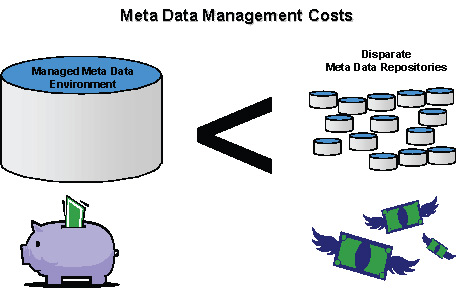Meta Data Silos – Part 2
By David Marco
In my last column I discussed the issue of disparate meta data repositories and the four most common problems created by this phenomenon.
-
Missing Meta Data Relationships
-
Typically Built By Non-Meta Data Professionals
-
Costly Implementation and Maintenance
-
Poor Technology Selections
Last month, I discussed Missing Meta Data Relationships and Typically Built By The Non-Meta Data Professional. In this month’s column I will address the final two problems and discuss why they exist.
Costly Implementation and Maintenance
Typically business units and technical groups need meta data and well functioning managed meta data environments (MME) to properly run their business and their I (information technology) T systems. Therefore, these groups will not be able to wait around for their company to start building their MME, assuming that they may not even have such a project in their current IT plans. As a result, they run off and build these disparate meta data repositories solutions that are designed to only handle one or two specific problems/challenges. If executive management knew the cost of these meta data repository point solutions they would see that it far outweighs the cost of a truly sound enterprise-wide MME. This situation closely follows the path that many companies have taken with data warehousing. For example, the average company needlessly replicates their data warehousing efforts across many of their lines of business, as opposed to centralizing this function. It has been my experience that this approach typically increases the costs of data warehousing by over 300%. These companies could provide all of the data warehousing functionality that they provide today at less than a third of the cost, if they just managed their IT systems properly. The types of organizations that build point meta data solutions are traditionally concerned by the cost of building a MME. However, the cost of the MME would pale in comparison to the costs of all of the disjointed meta data initiatives that are currently underway or in production (see Figure 1: “Meta Data Management Costs”. Doing it right the first time is always less costly than doing it wrong and trying to fix it later.

Figure 1: Meta Data Management Costs
Typically Built By Non-Meta Data Professionals
When government agencies and corporations have disparate meta data repositories, invariably most of these applications are being built by both consultants and employees that are not qualified to do so. This is highlighted by the fact many consulting and software firms are entering the meta data management field even though they have little to no experience in this area. Meta data professionals are like data warehouse practitioners. They are professionals that study their craft and have made it their full-time and in many instances their life-work. You cannot take an operational systems person or even a data warehousing person and expect them to work in the meta data arena if they are lacking the proper knowledge, training and experience.
A MME is not a data warehouse or an operational system. Building the MME incorrectly will only lead to having to rebuild it again in the future. I have published hundreds of articles in my career; however, only once did I ever write a predictions article where I attempted to say what will happen over the upcoming years. It was October of 1999 and I needed to write my January 2000 column. In approaching this column I thought that if I’m ever going to write a predictions article it must be for my first article of the new millennium. How could I resist? My number one concern for this column was making sure that the predictions I made would come true, as I knew that someone would inform me if I missed any of my Nostradamus-like forecasts. Therefore, my first prediction was that “During the 1990s, corporations raced to build their decision support systems as quickly as they could…in their zeal to do this too many of these organizations neglected to build the architecture necessary to grow their systems over time.[1]”
We see today that data warehousing is becoming a standard practice in most companies and government agencies. Companies no longer ask if they should build a data warehouse, they ask how it should be built. If you look at MMEs and meta data management, it looks very similar to how data warehousing appeared in the early 1990s. The companies that used proper data warehousing architecture and techniques have not be hampered by the high costs associated with disparate environments. Those companies that build sound enterprise-wide MME will have a distinct advantage over those corporations and agencies that when down the disparate path.
About the Author
Mr. Marco is an internationally recognized expert in the fields of enterprise information management, data warehousing and business intelligence, and is the world’s foremost authority on meta data management. He is the author of several widely acclaimed books including “Universal Meta Data Models” and “Building and Managing the Meta Data Repository: A Full Life-Cycle Guide”. Mr. Marco has taught at the University of Chicago, DePaul University, and in 2004 he was selected to the prestigious Crain’s Chicago Business “Top 40 Under 40” and is the chairman of the Enterprise Information Management Institute (www.EIMInstitute.org). He is the founder and President of EWSolutions, a GSA schedule and Chicago-headquartered strategic partner and systems integrator dedicated to providing companies and large government agencies with best-in-class solutions using data warehousing, enterprise architecture, data governance and managed meta data environment technologies (www.EWSolutions.com). He may be reached directly via email at DMarco@EWSolutions.com
[1] “Data Warehousing Trends for 2000”, David Marco, DM Review, January 2000.